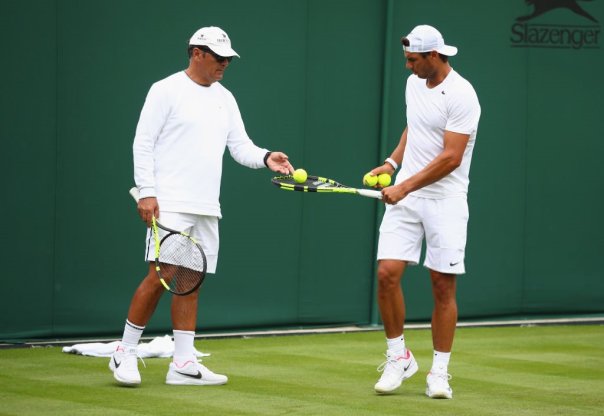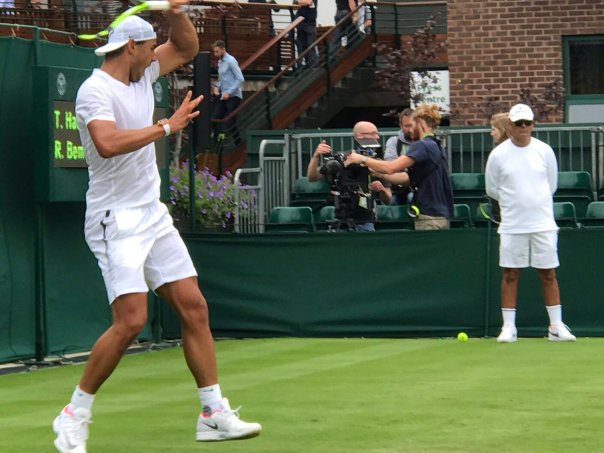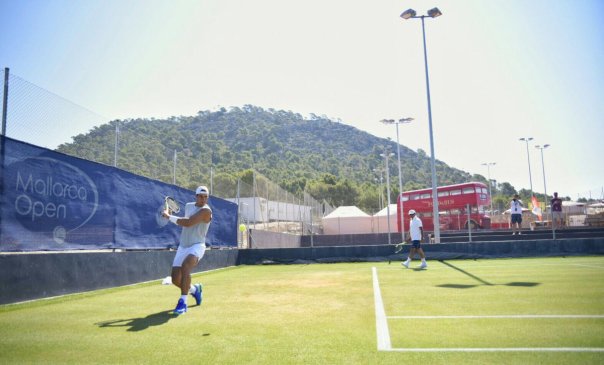This gallery contains 1,042 photos.
Blog Archives
From Mallorca to Roland-Garros: the Nadal-Moya story
From rollandgarros.com
He’s the chosen one to succeed “tio Toni”. At the end of 2016, Rafael Nadal brought Carlos Moya on board as his co-coach alongside the ever-present uncle Toni, who will step down as his coach at the end of 2017. These two Mallorcans, fellow Roland-Garros champions with a ‘big brother-little brother’ bond, are as natural a pairing as they come. We take a look at the link between the long-standing friends-cum-foes, which goes all the way back to Rafa’s teenage years and has centred on Mallorca and Paris. Now their relationship has entered a – successfull! – new chapter with the win of the “Decima”, the tenth Rafael’s title at Roland-Garros.
Episode 1: In Moya’s footsteps in Majorca
“I wish you a career just like mine.”
“No, I want more.”
As recounted in Rafael Nadal’s autobiography, Rafa: My Story, this was one of the exchanges when the fresh-faced 13-year-old – at the time billed as the next big thing in Majorcan tennis – first met Carlos Moya, then the reigning Roland-Garros champion and freshly crowned as the world number one. This encounter was the starting point of a long history between Moya, who put his homeland on the tennis map in the 1990s, and Nadal, who has become practically synonymous with Majorca – a shifting relationship that began on the pair’s native island and was destined to continue on bigger stages.
Moya was a childhood hero and role model who became, in Nadal’s words, more like a “big brother” than a mere mentor. Indeed, despite his status as an ATP star, Moya took it upon himself to do whatever he could to aid the development of this budding teenager who dreamed of conquering the world. “Everyone in Majorca knew that this kid was one to watch, and not just because he was the nephew of Miguel Ángel Nadal, the Barça player,” Moya recalled. “He won the island’s under-12s championship at the age of eight! My first coach, Jofre Porta, had worked with him a little back then and had told me, ‘This guy could be the real deal.’“
Despite – or perhaps because of? – Nadal’s conduct on being introduced to his older compatriot (a show of cockiness for which, incidentally, he was grounded by his parents), Moya enlisted young Rafael as his hitting partner whenever he came back to Majorca thereafter. “People sometimes tell me that I helped Rafa, but it was actually reciprocal,” Moya stressed, “He was already good enough to push me in practice. When we played sets, I couldn’t afford to go easy if I didn’t want to be beaten by a 14-year-old!” As for the youngster, he was certainly in good hands: how many teenagers have the chance to regularly rally with a top-ten player?

Episode 2: Under Charly‘s wing on tour… and a swift coming of age
Ironically, the man affectionately known as Charly was also one of Nadal’s first big-name victims on tour: the starlet’s victory in their meeting at the 2003 Hamburg Masters gave him his maiden top-five scalp. “Up to that point, I’d win most of our practice sets,” Moya went on. “In fact, I’d say that whenever I really wanted to win, I won. As you would have expected. But during that match, I felt incredibly nervous. I was a top-ten player, while for all his promise, he was only 16! Losing would be embarrassing for me and that feeling really got to me. It was cold and I had the impression that I couldn’t quite get my game going, while he seemed to be in the zone from the very first stroke of the warm-up. He played a remarkable match, keeping his focus from the first point to the last, and I lost in two sets.“
This upset did not represent a power shift – at least not yet – between the duo, who also love to compete off the court through video games. Nevertheless, “That day, I realised what sort of player Rafael could become: someone who, with his reading of the complexion of matches and his ability to block out everything else, could be a cut above the best that I was capable of – even though I’d won Roland-Garros and reached the Australian Open and Masters Cup finals by that point. We walked up to the net and, as we hugged, Rafa said ‘I’m sorry’. But he had no reason to be. I was philosophical about it – more so than I would’ve thought. I knew that it was the first of a series of defeats to come. He was the future. As for me, though I was a long way from finished, my decline had begun.”
Episode 3: Moya unleashes Nadal’s inner beast
Fast-forward a year to 2004 and Moya remained the Spanish number one and the undeniable leader of the Davis Cup team that had qualified for the final of the competition. However, it was 18-year-old Rafa who had stolen the show in the semi-finals against France, shining in the doubles win over Arnaud Clément and Michaël Llodra that put La Roja in the lead and then sealing victory in the tie by overcoming Clément in the fourth rubber. Yet, although they say ‘don’t change a winning formula’, Nadal’s place in the team for the showpiece was no foregone conclusion – on paper, Juan Carlos Ferrero, who had been the world number one just 12 months earlier, or even Tommy Robredo, who was up at 17th in the rankings while Nadal was hovering around the 50 mark, seemed safer picks.
And so it was that a selection debate raged in the lead-up to the final against a United States team spearheaded by Andy Roddick, a regular thorn in Ferrero and Robredo’s sides on tour. Moya was no idle spectator and subsequently threw all his weight behind captain Jordi Arrese’s brave decision to plump for the comparative rookie, despite the stir it caused within the camp and Nadal’s own misgivings: “He came to me and said that he couldn’t just usurp Juan Carlos and Tommy, two established champions, like that,” Moya revealed. “And Toni felt the same way. I had to hammer home to them that Rafa wasn’t taking anyone’s place, that he was a totally legitimate choice to play the singles and that he had my full confidence. He’d played a part in us getting to the final and there was nothing undeserved about his presence in the line-up.“
It was a calculated gamble – “I’d got to know Rafa. I knew that that shy, well-mannered boy in everyday life was the sort who would be galvanised by the crowd and the occasion” – and it paid off. Feeding off the 27,000 fans at Seville’s Olympic Stadium (a record for a tennis match at the time), the youngster delivered in majestic fashion, outfoxing and outlasting Roddick – then the world number two – to help Spain towards their second Davis Cup crown, with Moya clinching glory. “In a way, I unleashed the beast that day,” the 40-year-old quipped with a smile.

Episode 4: Roland-Garros role reversals
2007 brought a swansong for the then fading Moya, as the old warhorse worked his way back into the top 20 at the age of 31, thanks in no small part to quarter-final showings at Roland-Garros and the US Open. Fittingly, his last hurrah in Paris – this would prove his final run to the quarters at the tournament where he had once been the kingpin – was ended by Nadal. In a match full of symbolic significance, Rafa pulled no punches and cruised to a 6-4, 6-3, 6-0 victory over his “big brother“, whose attacking game was gradually tamed by the extraordinary court coverage of the younger man, then on the march towards a third French Open title on the bounce.
Ten years since their lone clash at Roland-Garros, the pair has returned there in tandem in 2017, with the 1998 champ having joined his former protégé’s coaching team. In the interim, Nadal has emerged as the leading contender for the crown of the best clay-courter of all time, having achieved unprecedented success on the fabled red dirt of the French capital: his previously unthinkable tally of nine titles in ten years (2005-2014) was three more than Björn Borg managed and two more than Chris Evert racked up on the women’s side. But Rafa had two difficult years in 2015 and 2016, plagued with injuries, two years without winning Roland-Garros – an eternity for him!
Moya, meanwhile, has never been too far away from the scene since retiring – he could even be found serving as a heavyweight hitting partner for Rafa before certain French Open finals. Even more pertinently, perhaps, he completed his coaching apprenticeship with flying colours in 2016, contributing towards Milos Raonic’s breakout campaign, which saw the Canadian finish the year ranked third in the world.
A legend seeking to continue earning his coaching spurs and a star searching for a second wind after two hugely disappointing seasons by his own lofty standards. It has all the makings of a match made in heaven. After all, given Nadal’s well-known loyalty to his ‘clan’ (his team consists almost exclusively of Majorcans, most of whom have been in the picture since the early days), it was entirely logical that, having decided to bring in a new face, Moya was the chosen one.
Indeed, they seem such a natural fit that arguably the only surprising thing is how long it took to happen. Whatever the case may be, as he enters what are likely to be his twilight years at the highest level, at 31, Rafa has gone full circle by reaching out to the champion who took him under his wing when he was just a teenager. This is perfectly in keeping with one of the credos underpinning Nadal’s career: only by looking at where you’ve come from can you know where you’re going. And with the win of the “Decima” of all the records, the logical choice was clearly the right choice.
Carlos Moya, Toni Nadal and Francisco Roig (next to Toni): three coaches and a champion






































